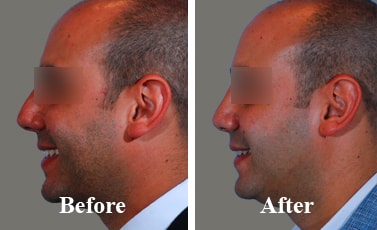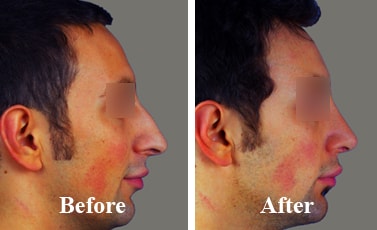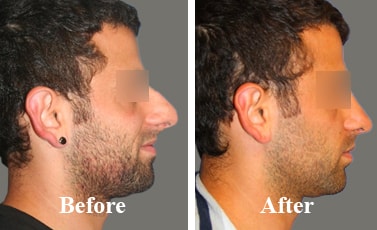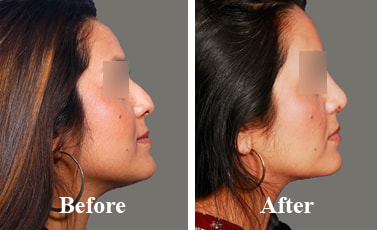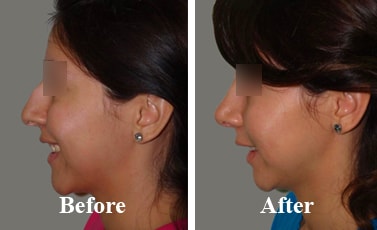Reshape Your Nose As You Want
Best Rhinoplasty Surgeon in Jabalpur Get Your Nose Reshaped from Best Surgeon!
Rhinoplasty Surgery Clinic in Jabalpur, India - Rhinoplasty, sometimes referred to as a "nose job" or "nose reshaping" by patients is a plastic surgery procedure for correcting and reconstructing the form, restoring the functions, and aesthetically enhancing the nose. Most patients ask to remove a bump, narrow nostril width, change the angle between the nose and the mouth, as well as correct injuries, birth defects, or other problems that affect breathing. Find the best Rhinoplasty Clinic in Jabalpur, India.
CALL NOW & GET DISCOUNT: 8329060384
Free Consultation, Best Treatment, Lowest Cost, Easy Finance Available, 100% Result
Rhinoplasty Surgery Cost in Jabalpur Know the Cost of Nose Job, Deals & Offers in Jabalpur
Rhinoplasty Cost Depends on?
Nose surgery costs in Jabalpur, India - Rhinoplasty surgery costs can vary widely. The cost of Rhinoplasty Surgery depends on Anesthesia fees, Hospital or surgical facility costs, Medical tests, Post-surgery garments, Prescriptions for medication, Surgeons fee, Clinic stay etc. A surgeons fee will be based on his or her experience and geographic office location. When choosing a board-certified plastic surgeon in your area for a rhinoplasty procedure, remember that the surgeons experience and your comfort with him or her are just as important as the final cost of the surgery.
Fill the form to know the approx cost of Nose surgery for your case in India.
Contact Us
Find detailed information about Rhinoplasty, Side Effects, Pre-Post Procedure Care, FAQs & Choose a Rhinoplasty surgeon you can trust in Jabalpur, India. If you are a Surgeon from Jabalpur, India, you are most welcome to join our network & If you are looking for Rhinoplasty you can find doctors, Ask your doubts about Rhinoplasty or read the blogs. We have tried to list best Clinics, doctors & surgeons in & near Jabalpur, India. Please fill the form to schedule your free consultation with one of our affiliate clinic in Jabalpur, India. To know the approximate cost of Rhinoplasty Procedure, click on - http://www.rhinoplastysurgery.co.in/cost-financing/.
rhinoplasty clinic near me, "nose plastic surgery cost", nose reshaping surgery cost, "plastic surgery of nose", "nose job", rhinoplasty specialist near me, nose surgery price in india, best rhinoplasty surgeon in india, nose surgery, best nose doctor, nose rhinoplasty cost, rhinoplasty surgery cost, nose surgery doctor, "price for nose plastic surgery", crooked nose surgery cost, nose operation price, nose reshaping cost, rhinoplasty cost, nasal plastic surgery, rhinoplasty cost in india, nose surgery near me, doctor for nose surgery, nose surgery cost, crooked nose surgery, rhinoplasty surgery
The information provided by this site is meant for general purposes only and should not be seen as a substitute to advice from medical doctors. Do not take it as a treatment guide. Do consult your physician as different cases demand different attention. We do not claim information provided here to be of professional nature. If anything goes wrong with anyone acting upon information provided on the site, Rhinoplastysurgery.co.in won’t responsible for it. The photos seen on the site are for the purpose of representation only. Results of surgeries differ greatly from patient to patient and can’t be guaranteed.
Patients Travel Long Distances for specialists of Rhinoplasty and Face Lift Surgery
Facial plastic corrective medical procedure poses exceptional difficulties for the specialist as well as for the patients. Expanded learning of medications among people in general is additionally currently connected with expanded desires and requests.
All Jabalpur rhinoplasty, Jabalpur facelift and different patients express worries about protecting their self-identity while in the meantime upgrading their characteristic potential. Exceptionally qualified specialists with worldwide reputations comprehend that keeping in mind the end goal to fulfill these requests facial plastic medical procedure must be performed wisely with mindfulness that no careful intercession is just shallow. Specifically, facial tasks not just require careful learning of the internal structures and their working yet additionally an adjusted imaginative capacity.
Such ability is generally clear in taking a gander at careful outcomes. With the accessibility of the Internet, the decision is made simpler. This might be one factor clarifying the expanding pattern in which patients traverse nations and here and there even mainland’s looking for the best care.
Since the face is an exceptionally unique anatomical district, patients need to be sure beyond a shadow of a doubt about the most obvious opportunity with regards to their desires being met. Travel to acquire merchandise is managed by saving money on bring down costs, on account of improving individual picture with better facial style, such motivating force does not assume a part. The decision of the specialist is important to the point that it dominates the burden and expenses of movement fundamental, now and again requiring something beyond one visit.
The new kind of facelift that we presented in India has pulled in a great deal of consideration because of its astounding outcomes and less symptoms, and is one reason, I have discovered, that has drawn remote and away patients.
A unique system for rectifying beforehand unsuitable aftereffects of rhinoplasty medical procedure, which was produced here, at the University of Toronto, gave a modest bunch of specialists the favourable position to offer arrangements which were already not accessible. Roughly 60% of my rhinoplasty rehearse is contained this kind of activity; a significant number of them are patients from far away.
Numerous patients who will go for facial restorative medical procedure medications are profoundly situated in the political, business and masterful universes yet it is fascinating for me to take note of that away customer base is absolutely not constrained to this gathering either.
In perspective of the way that this kind of medical procedure in many occasions is not carried out in public hospitals, which are not all around prepared for these absolutely elective medicines, an uncommon office is required to oblige the patients' needs and additionally furnish a sheltered situation with very much prepared, experienced work force. Such offices ought to be confirmed by an accreditation body. Our foundation gives an inn suite situated in the centre site for the accommodation and protection of the patients who originate from far off. The expanded number of these voyaging patients required such a course of action. A ton of neighbourhood patients likewise utilize this administration for solace and significant serenity.
Rhinoplasty is cosmetic surgery of the nose. It is one of the star operations of cosmetic surgery. More than any other operation, the result must be irreproachable, as it shows. Find out what you need to know before considering such an operation.
Summary
- What does rhinoplasty consist of?
- The consultation before a rhinoplasty
- The course of the intervention
- The operative consequences of a rhinoplasty
- Benefits of rhinoplasty
- Contraindications to rhinoplasty
- Cost and management of rhinoplasty
- The expert's opinion
For rhinoplasty as for other cosmetic surgery techniques , the dialogue between the patient and the surgeon is of paramount importance. It will determine what is desired by the patient, technically feasible and aesthetically suitable. Currently, there are nearly 15,000 nose operations per year, or 5% of cosmetic surgery in France.
What does rhinoplasty consist of?
Rhinoplasty refers to plastic and cosmetic surgery of the nose, in order to correct any disgrace present (whether congenital, following trauma or aging). We must therefore differentiate:
- Functional rhinoplasty, the aim of which is to straighten the septum, which is the source of respiratory difficulty;
- Aesthetic rhinoplasty, the aim of which is to modify the morphology of the nose, either at the level of its upper bony part, or of its mobile lower part called cartilaginous.
We can thus straighten, shorten or reduce in height and width a nose in its two bone and cartilaginous structures. Functional and corrective surgeries can be combined, this is called septo-rhinoplasty. Rhinoplasty can be combined with other cosmetic surgery procedures such as genioplasty (modification of the chin). This intervention can be performed in men as well as in women. However, it is recommended to wait for the end of growth before practicing it, from around 17 years old.
The consultation before a rhinoplasty
UNDERSTAND THE PATIENT'S EXPECTATIONS
The essential step is to clearly define the objectives of the rhinoplasty. The patient must fully explain his desires for change. Work on black and white medical photographs is essential. It allows to perform simulations (morphing), in particular of profile and to imagine the expected result. This is also the time for the patient to ask any questions.
THE IMPORTANCE AND LIMITATIONS OF COMPUTER SIMULATIONS
Head-on simulations are, unfortunately, less accurate. You have to be wary of the results, especially on a computer which will not necessarily represent the final result. Nevertheless, a simulation is essential to approach the result and thus better personalize the surgical intervention. Indeed, no two faces are alike and "tailor-made" is essential. Finally, several factors can intervene in the surgical technique and in its result: the structure of the bones of the nose, the cartilage, the shape of the face, the smoothness of the skin ...
THE NOSE IS AN ESSENTIAL ELEMENT OF THE WHOLE FACE
The surgeon must guide the patient and warn him that this intervention always results in a significant transformation in the face, which can modify its harmony.
The face is made of interdependent elements. Modifying the nose is also modifying the importance of an upper lip and above all modifying the importance of the chin in relation to the overall structure of a face. Apart from the chin, however, it is rare for the surgeon to offer an associated procedure, at the same time of operation, especially if the rhinoplasty is complete.
LIMITS OF THE OPERATION
As part of a functional intervention aimed at improving breathing, the surgeon should warn the patient that in the event of chronic disease of the nasal mucosa, the result may not be complete.
The quality of the skin is involved in the final result of a rhinoplasty. Thick, oily skin will not achieve the desired refinement, especially at the tip of the nose. Another limitation of rhinoplasty is the existence of very large nostrils.
A reduction is certainly possible but at the cost of external scars which must therefore be accepted. In fact, in almost all cases, apart from a major deformation (especially of the tip of the nose) and often congenital, all the scars are hidden under the rim or inside the nose. All this must be specified preoperatively.
The course of the intervention
The patient's requests have been clearly identified, he must bring the photographs and the simulation chosen to the surgeon on the day of the operation. The surgeon carefully studied the nasal pyramid and conducted an endonasal examination. This makes it possible to plan the surgical procedures during the operation.
If it is not an intervention with a restorative aim, a period of 15 days between the first consultation and the operation must be respected (this is a mandatory reflection period for all acts for aesthetic). Before the operation, a visit to the anesthesiologist is mandatory.
A detailed estimate and an operating file are given to the patient.
PREOPERATIVE ASSESSMENT
A preoperative blood test is performed as prescribed. The professional must ensure that there is no contraindication to surgery. A radiological examination may also be requested depending on the correction to be made (especially in the case of reconstructive rhinoplasty).
Some recommendations should be observed before cosmetic surgery of the nose:
- It is advisable to stop smoking at least one month before and after the surgery so as not to hamper healing;
- The intake of aspirin is prohibited during the 10 days preceding the operation;
- Stopping oral contraception may be requested in the event of other risk factors for phlebitis (obesity, poor venous condition, coagulation disorders);
- The skin will be disinfected with an antiseptic solution or soap applied the day before and the morning of the operation;
- It is recommended not to eat or drink anything 6 hours before the operation.
The anesthesia is either general or local, associated with diazanalgesia allowing the patient to be relaxed. In the event of surgery on the nasal septum or complete rhinoplasty with mobilization of the bone part, general anesthesia is preferable because it is more comfortable.
In case of rhinoplasty localized at the tip of the cartilaginous nose or as a simple grating of a mini bump, local anesthesia associated with diazanalgesia is most often sufficient.
The choice of anesthesia is the result of a discussion between the patient, the surgeon and the anesthesiologist.
THE INTERVENTION LASTS FROM 30 MINUTES TO TWO HOURS
The intervention lasts from 30 minutes to 2 hours depending on the modifications to be made. In the event of partial rhinoplasty, hospitalization may last only one day. On the other hand, in the event of complete rhinoplasty associated with septum surgery, overnight hospitalization is to be expected.
Although each surgeon can adopt their own procedures, there are a few basic principles:
- Most often, the incisions are concealed inside the nostrils or under the upper lip so that they are not visible from the outside. In rare cases, external scars are necessary: to reduce the size of the nostrils, the scars will then be hidden at the base of the wings of the nose; in the event of open rhinoplasty - to access the nasal infrastructure - in the event of significant deformities or surgical revision, the scars will be across the columella (pillar separating the two nostrils).
- Through these incisions, the bone and cartilage framework will be isolated by peeling off the skin on the outside and the mucous membrane on the inside.
- The osteocartilaginous infrastructure is then corrected according to the chosen simulation: reduction of a too wide nose, removal of a bump, correction of a deviation, shortening a too long nose, etc. The use of cartilaginous or bone grafts can be necessary.
- The incisions are closed with small threads, most often absorbable.
- Dressings and a splint (in plaster, plastic or metal) molded and fixed to the nose, provide support and protection.
The operative consequences of a rhinoplasty
The consequences are rarely painful and the main constraint is related to the inability to breathe through the nose (due to edema). The time of postoperative follow-up, which varies depending on the type of rhinoplasty, is of the order of 7 to 15 days:
- Possibility of wicks for 1 to 3 days;
- From a small splint endo-nasal if the partition surgery removed between the 5 thand 8 th day after surgery. It can be replaced by a smaller splint for a few days;
- A nasal dressing (either steristrip, or small plasticized or plastered plate) which remains in place for 10 days if a gesture on the shape of the nose has been performed. When the dressing is removed, an acneiform outbreak on the nose is possible, it will be resolved by local medical treatment;
- Possibility of edema in the eyelids, edema or bruising, the extent and duration of which vary from one person to another.
- There is no ablation of stitches because the threads placed inside the nose are absorbable. This procedure is not painful and pain should alert the surgeon to the possibility of infection.
The time to resume social and professional activity will depend on the duration of this external dressing and the possibility of bruising on the eyelids and cheek, the importance of which varies according to the individual. It is estimated that it is on average 10 to 20 days. After the splint is removed, the nose may appear even more massive and respiratory discomfort may persist (due to swelling of the mucous membrane or the presence of scabs in the nasal cavities).
The nose remains fragile for 1 month. You must avoid any risk of shock and any traumatic gesture (blowing your nose violently ...). Sport and violent activities are prohibited for 3 months. Sun exposure is possible as soon as the bruises are gone.
RISKS ASSOCIATED WITH RHINOPLASTY
Recourse to a surgeon authorized for this type of intervention, registered with the council of the medical order and practicing in a truly surgical context, makes it possible to limit complications, and, if necessary, to ensure effective and personalized follow-up.
If the outcome is usually satisfactory, the plastic surgeon should inform his patients of all complications, even the most exceptional. The risks associated with anesthesia will be discussed by the anesthetist: thromboembolic accident (phlebitis, embolism).
POSSIBLE COMPLICATIONS OF RHINOPLASTY
Postoperative complications and risks are rare today. The preoperative examinations and consultations with the plastic surgeon and the anesthetist are aimed at eliminating all risks and complications as much as possible. Nevertheless, the patient must always be informed of the possible complications: bleeding (possibly in the first hours but which is usually moderate), hematomas (if they are too large, they may require evacuation), infection (very rare , it can justify a treatment), unsightly scars (very rare and concern only visible scars, therefore already limited cases), skin damage (exceptional, cutaneous necrosis can leave visible marks. They are favored by smoking),small residual roughness which may require remote reoperation.
Benefits of rhinoplasty
The patient should not be worried when the external dressing is removed, as it takes a few months for the desired changes to be permanent. In profile, the nose can still go up, then go down in the following weeks. The apparent enlargement of the nose, due to the edema present in the bone sector and in the cartilaginous sector, takes longer to resolve:
- After 3 months, we have a good overview of the result;
- After 6 months the final appearance of the nose is obtained with, in particular, the thinning of the tip of the nose. The flexibility of the tip of the nose returns even later;
- The final evaluation of the nose is done at 1 year.
Irregularities on palpation, if they do not have a visual translation, are quite possible and should be neglected. However, it should be noted that due to the consolidation and evolution of internal healing, in 5% to 10% of cases (depending on the type of rhinoplasty performed) retouching may be necessary and the patient must be informed beforehand. .
The impression of dark circles, especially if one has a dark lower palpebral complexion, can be aggravated which justifies solar eviction during the first 6 months.
IMPERFECT RESULTS
The imperfections of results are rare or result from a misunderstanding on the objectives to be reached or from the exceptional occurrence of scarring or unexpected tissue reactions. If these imperfections are not well tolerated, they can be corrected by surgical retouching (simpler than the initial surgery), which however cannot take place for several months.
Contraindications to rhinoplasty
There are some important contraindications to this surgery, which will be identified during the preoperative assessment:
- A history of phlebitis or pulmonary embolism may constitute formal contraindications to this operation;
- Smoking increases the risk of skin necrosis, which can delay healing and delay healing. It is therefore recommended to stop smoking one month before the operation and as many after;
- Taking hormonal contraceptives increases the risk of phlebitis. In the event of other risk factors (obesity, poor venous condition, coagulation disorders), it may be requested to stop it one month before the operation;
- Taking aspirin or its derivatives is contraindicated in the week preceding the operation.
Cost and management of rhinoplasty
Rhinoplasty for aesthetic purposes ("you don't find your nose very pretty") is not reimbursed.
If the rhinoplasty aims to correct a deviation of the nasal septum, which leads to respiratory problems, a request for reimbursement by Social Security is possible.
If the rhinoplasty aims to straighten a nose deformed by a congenital malformation or an accident which seriously complicates the patient and poses social or professional problems, a request for treatment under the psychological factor is possible.
For treatment, the surgeon will have to write a request for prior agreement that the patient will have to submit to his or her social security center. The medical adviser will then check the clinical elements and give his or her agreement or not. If it is covered, the fees remaining payable by the patient may nevertheless be reimbursed by your mutual.
The cost of a rhinoplasty varies. These prices vary greatly depending on health insurance coverage, costs linked to the clinic, the type of anesthesia, the specificities of each patient and the prices specific to the surgeon. A precise estimate must be given during the consultation, well before the operation.
The expert's opinion
The vast majority of rhinoplasties correct a too projected nose, a too sharp point, a too prominent bump. In these so-called “reduction” rhinoplasties, except in certain treatments for the tip of the nose, the plastic surgeon will always take care to avoid cartilage grafts. Indeed, the latter always have a risk of moving, deforming or being reabsorbed. There is, therefore, an interest in avoiding any part of the unknown on healing and thus on the aesthetic result.
In addition, the surgeon will take care to avoid any “over-correction”, ie too large a reduction in the nose which would be difficult to correct (by cartilage grafts) for the reasons we have just seen.
While a male nose should be straight and even a little convex (a moderate bump is not necessarily unsightly in a man ..), a female nose should be slightly concave but not too deep. The best result is the one that is not visible.
